Particular because of Robert Sams for the event of Seignorage Shares and insights relating to easy methods to appropriately worth unstable cash in multi-currency techniques
Be aware: we aren’t planning on including worth stabilization to ether; our philosophy has at all times been to maintain ether easy to attenuate black-swan dangers. Outcomes of this analysis will seemingly go into both subcurrencies or impartial blockchains
One of many important issues with Bitcoin for unusual customers is that, whereas the community could also be an effective way of sending funds, with decrease transaction prices, rather more expansive international attain, and a really excessive stage of censorship resistance, Bitcoin the foreign money is a really unstable technique of storing worth. Though the foreign money had by and enormous grown by leaps and bounds over the previous six years, particularly in monetary markets previous efficiency isn’t any assure (and by environment friendly market speculation not even an indicator) of future outcomes of anticipated worth, and the foreign money additionally has a longtime popularity for excessive volatility; over the previous eleven months, Bitcoin holders have misplaced about 67% of their wealth and very often the value strikes up or down by as a lot as 25% in a single week. Seeing this concern, there’s a rising curiosity in a easy query: can we get one of the best of each worlds? Can now we have the total decentralization {that a} cryptographic cost community affords, however on the similar time have the next stage of worth stability, with out such excessive upward and downward swings?

Final week, a crew of Japanese researchers made a proposal for an “improved Bitcoin”, which was an try and do exactly that: whereas Bitcoin has a hard and fast provide, and a unstable worth, the researchers’ Improved Bitcoin would fluctuate its provide in an try and mitigate the shocks in worth. Nevertheless, the issue of creating a price-stable cryptocurrency, because the researchers realized, is way completely different from that of merely organising an inflation goal for a central financial institution. The underlying query is harder: how can we goal a hard and fast worth in a method that’s each decentralized and sturdy towards assault?
To resolve the difficulty correctly, it’s best to interrupt it down into two largely separate sub-problems:
- How can we measure a foreign money’s worth in a decentralized method?
- Given a desired provide adjustment to focus on the value, to whom can we problem and the way can we take in foreign money models?
Decentralized Measurement
For the decentralized measurement downside, there are two recognized main courses of options: exogenous options, mechanisms which attempt to measure the value with respect to some exact index from the skin, and endogenous options, mechanisms which attempt to use inside variables of the community to measure worth. So far as exogenous options go, thus far the one dependable recognized class of mechanisms for (presumably) cryptoeconomically securely figuring out the worth of an exogenous variable are the completely different variants of Schellingcoin – primarily, have everybody vote on what the result’s (utilizing some set chosen randomly based mostly on mining energy or stake in some foreign money to stop sybil assaults), and reward everybody that gives a consequence that’s near the bulk consensus. If you happen to assume that everybody else will present correct info, then it’s in your curiosity to supply correct info so as to be nearer to the consensus – a self-reinforcing mechanism very similar to cryptocurrency consensus itself.

The primary downside with Schellingcoin is that it isn’t clear precisely how steady the consensus is. Notably, what if some medium-sized actor pre-announces some different worth to the reality that may be helpful for many actors to undertake, and the actors handle to coordinate on switching over? If there was a big incentive, and if the pool of customers was comparatively centralized, it won’t be too troublesome to coordinate on switching over.
There are three main elements that may affect the extent of this vulnerability:
- Is it seemingly that the contributors in a schellingcoin even have a typical incentive to bias the end in some path?
- Do the contributors have some widespread stake within the system that may be devalued if the system had been to be dishonest?
- Is it doable to “credibly commit” to a selected reply (ie. decide to offering the reply in a method that clearly cannot be modified)?
(1) is reasonably problematic for single-currency techniques, as if the set of contributors is chosen by their stake within the foreign money then they’ve a robust incentive to faux the foreign money worth is decrease in order that the compensation mechanism will push it up, and if the set of contributors is chosen by mining energy then they’ve a robust incentive to faux the foreign money’s worth is just too excessive in order to extend the issuance. Now, if there are two sorts of mining, one in all which is used to pick out Schellingcoin contributors and the opposite to obtain a variable reward, then this objection now not applies, and multi-currency techniques also can get round the issue. (2) is true if the participant choice relies on both stake (ideally, long-term bonded stake) or ASIC mining, however false for CPU mining. Nevertheless, we must always not merely depend on this incentive to outweigh (1).
(3) is probably the toughest; it relies on the exact technical implementation of the Schellingcoin. A easy implementation involving merely submitting the values to the blockchain is problematic as a result of merely submitting one’s worth early is a reputable dedication. The unique SchellingCoin used a mechanism of getting everybody submit a hash of the worth within the first spherical, and the precise worth within the second spherical, form of a cryptographic equal to requiring everybody to place down a card face down first, after which flip it on the similar time; nevertheless, this too permits credible dedication by revealing (even when not submitting) one’s worth early, as the worth could be checked towards the hash.
A 3rd possibility is requiring all the contributors to submit their values straight, however solely throughout a particular block; if a participant does launch a submission early they’ll at all times “double-spend” it. The 12-second block time would imply that there’s virtually no time for coordination. The creator of the block could be strongly incentivized (and even, if the Schellingcoin is an impartial blockchain, required) to incorporate all participations, to discourage or forestall the block maker from choosing and selecting solutions. A fourth class of choices entails some secret sharing or safe multiparty computation mechanism, utilizing a group of nodes, themselves chosen by stake (maybe even the contributors themselves), as a form of decentralized substitute for a centralized server answer, with all of the privateness that such an strategy entails.
Lastly, a fifth technique is to do the schellingcoin “blockchain-style”: each interval, some random stakeholder is chosen, and informed to supply their vote as a [id, value] pair, the place worth is the precise legitimate and id is an identifier of the earlier vote that appears appropriate. The inducement to vote appropriately is that solely exams that stay in the primary chain after some variety of blocks are rewarded, and future voters will notice connect their vote to a vote that’s incorrect fearing that in the event that they do voters after them will reject their vote.
Schellingcoin is an untested experiment, and so there’s official motive to be skeptical that it’ll work; nevertheless, if we wish something near an ideal worth measurement scheme it is presently the one mechanism that now we have. If Schellingcoin proves unworkable, then we must make do with the opposite sorts of methods: the endogenous ones.
Endogenous Options
To measure the value of a foreign money endogenously, what we primarily want is to search out some service contained in the community that’s recognized to have a roughly steady real-value worth, and measure the value of that service contained in the community as measured within the community’s personal token. Examples of such providers embody:
- Computation (measured through mining issue)
- Transaction charges
- Information storage
- Bandwidth provision
A barely completely different, however associated, technique, is to measure some statistic that correllates not directly with worth, often a metric of the extent of utilization; one instance of that is transaction quantity.
The issue with all of those providers is, nevertheless, that none of them are very sturdy towards fast modifications attributable to technological innovation. Moore’s Legislation has thus far assured that almost all types of computational providers turn out to be cheaper at a fee of 2x each two years, and it might simply velocity as much as 2x each 18 months or 2x each 5 years. Therefore, making an attempt to peg a foreign money to any of these variables will seemingly result in a system which is hyperinflationary, and so we’d like some extra superior methods for utilizing these variables to find out a extra steady metric of the value.
First, allow us to arrange the issue. Formally, we outline an estimator to be a operate which receives an information feed of some enter variable (eg. mining issue, transaction value in foreign money models, and so on) D[1], D[2], D[3]…, and must output a stream of estimates of the foreign money’s worth, P[1], P[2], P[3]… The estimator clearly can not look into the longer term; P[i] could be depending on D[1], D[2] … D[i], however not D[i+1]. Now, to begin off, allow us to graph the best doable estimator on Bitcoin, which we’ll name the naive estimator: issue equals worth.
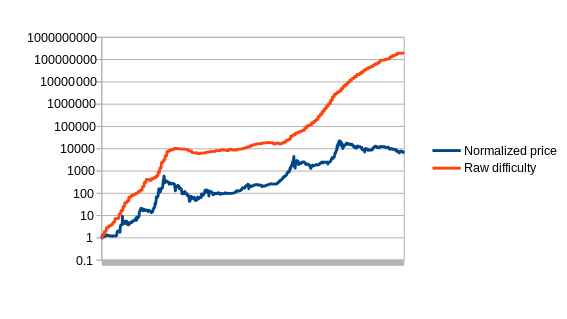
Sadly, the issue with this strategy is apparent from the graph and was already talked about above: issue is a operate of each worth and Moore’s legislation, and so it offers outcomes that depart from any correct measure of the value exponentially over time. The primary speedy technique to repair this downside is to attempt to compensate for Moore’s legislation, utilizing the problem however artificially decreasing the value by some fixed per day to counteract the anticipated velocity of technological progress; we’ll name this the compensated naive estimator. Be aware that there are an infinite variety of variations of this estimator, one for every depreciation fee, and all the different estimators that we present right here will even have parameters.
The way in which that we are going to choose the parameter for our model is by utilizing a variant of simulated annealing to search out the optimum values, utilizing the primary 780 days of the Bitcoin worth as “coaching information”. The estimators are then left to carry out as they’d for the remaining 780 days, to see how they’d react to circumstances that had been unknown when the parameters had been optimized (this system, is aware of as “cross-validation”, is customary in machine studying and optimization concept). The optimum worth for the compensated estimator is a drop of 0.48% per day, resulting in this chart:
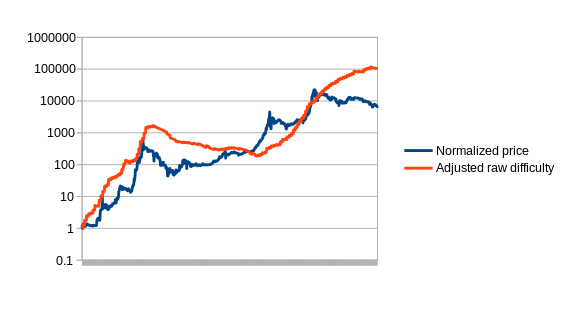
The following estimator that we are going to discover is the bounded estimator. The way in which the bounded estimator works is considerably extra sophisticated. By default, it assumes that every one development in issue is because of Moore’s legislation. Nevertheless, it assumes that Moore’s legislation can not go backwards (ie. know-how getting worse), and that Moore’s legislation can not go quicker than some fee – within the case of our model, 5.88% per two weeks, or roughly quadrupling yearly. Any development exterior these bounds it assumes is coming from worth rises or drops. Thus, for instance, if the problem rises by 20% in a single interval, it assumes that 5.88% of it is because of technological developments, and the remaining 14.12% is because of a worth enhance, and thus a stabilizing foreign money based mostly on this estimator would possibly enhance provide by 14.12% to compensate. The idea is that cryptocurrency worth development to a big extent occurs in fast bubbles, and thus the bounded estimator ought to have the ability to seize the majority of the value development throughout such occasions.
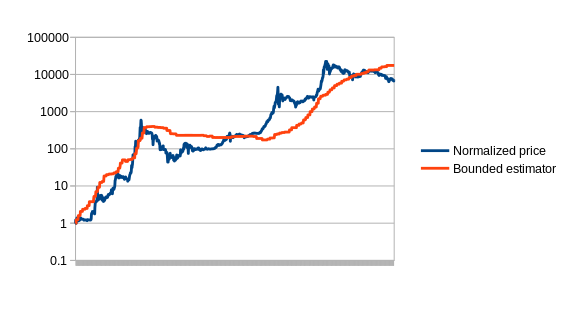
There are extra superior methods as properly; one of the best methods ought to have in mind the truth that ASIC farms take time to arrange, and in addition observe a hysteresis impact: it is typically viable to maintain an ASIC farm on-line if you have already got it even when underneath the identical circumstances it will not be viable to begin up a brand new one. A easy strategy is trying on the fee of enhance of the problem, and never simply the problem itself, and even utilizing a linear regression evaluation to mission issue 90 days into the longer term. Here’s a chart containing the above estimators, plus a couple of others, in comparison with the precise worth:
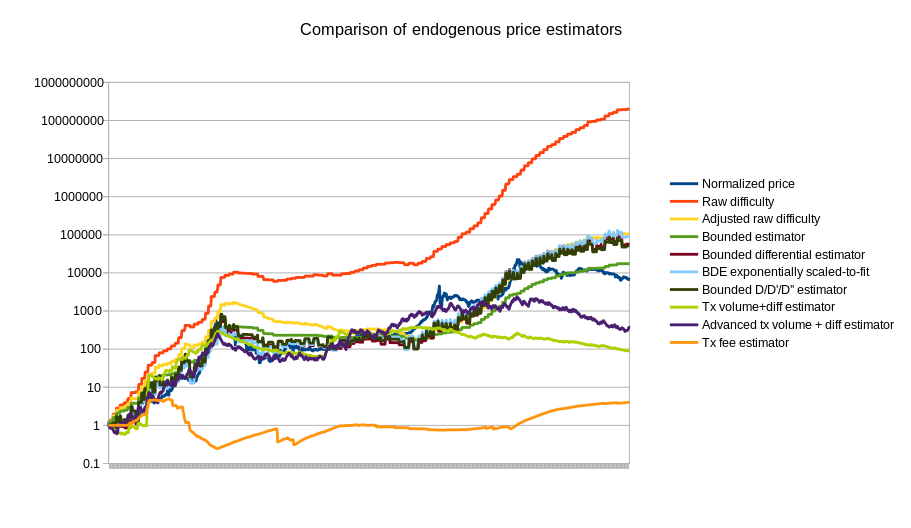
Be aware that the chart additionally consists of three estimators that use statistics aside from Bitcoin mining: a easy and a complicated estimator utilizing transaction quantity, and an estimator utilizing the typical transaction charge. We are able to additionally cut up up the mining-based estimators from the opposite estimators:
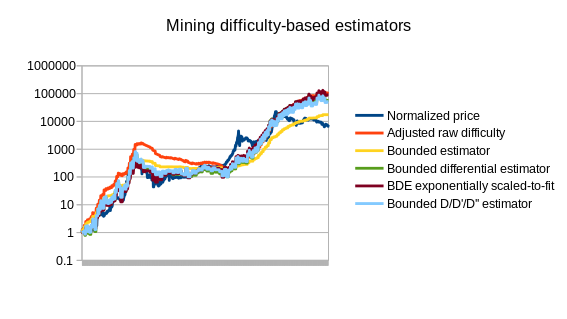 |
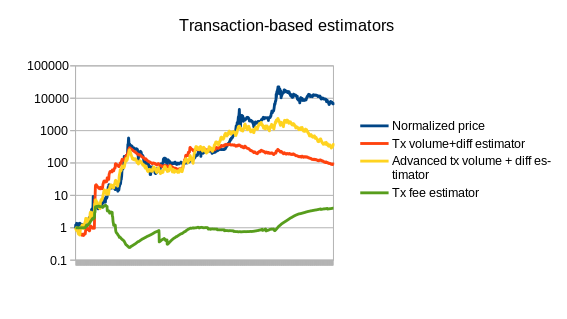 |
See https://ift.tt/DMQK9yh for the supply code that produced these outcomes.
In fact, that is solely the start of endogenous worth estimator concept; a extra thorough evaluation involving dozens of cryptocurrencies will seemingly go a lot additional. The perfect estimators might properly find yourself utilizing a mixture of various measures; seeing how the difficulty-based estimators overshot the value in 2014 and the transaction-based estimators undershot the value, the 2 mixed might find yourself being considerably extra correct. The issue can be going to get simpler over time as we see the Bitcoin mining economic system stabilize towards one thing nearer to an equilibrium the place know-how improves solely as quick as the final Moore’s legislation rule of 2x each 2 years.
To see simply how good these estimators can get, we will notice from the charts that they’ll cancel out no less than 50% of cryptocurrency worth volatility, and will enhance to ~67% as soon as the mining business stabilizes. One thing like Bitcoin, if it turns into mainstream, will seemingly be considerably extra unstable than gold, however not that rather more unstable – the one distinction between BTC and gold is that the provision of gold can truly enhance as the value goes greater since extra could be mined if miners are keen to pay greater prices, so there’s an implicit dampening impact, however the provide elasticity of gold is surprisingly not that excessive; manufacturing barely elevated in any respect through the run-ups in worth through the Seventies and 2000s. The worth of gold stayed inside a variety of 4.63x ($412 to $1980) within the final decade; logarithmically decreasing that by two thirds offers a variety of 1.54x, not a lot greater than EUR/USD (1.37x), JPY/USD (1.64x) or CAD/USD (1.41x); thus, endogenous stabilization might properly show fairly viable, and could also be most popular attributable to its lack of tie to any particular centralized foreign money or authority.
The opposite problem that every one of those estimators should cope with is exploitability: if transaction quantity is used to find out the foreign money’s worth, then an attacker can manipulate the value very simply by merely sending very many transactions. The common transaction charges paid in Bitcoin are about $5000 per day; at that worth in a stabilized foreign money the attacker would have the ability to halve the value. Mining issue, nevertheless, is rather more troublesome to use just because the market is so massive. If a platform doesn’t need to settle for the inefficiencies of wasteful proof of labor, an alternate is to construct in a marketplace for different sources, similar to storage, as an alternative; Filecoin and Permacoin are two efforts that try to make use of a decentralized file storage market as a consensus mechanism, and the identical market might simply be dual-purposed to function an estimator.
The Issuance Downside
Now, even when now we have a fairly good, and even excellent, estimator for the foreign money’s worth, we nonetheless have the second downside: how can we problem or take in foreign money models? The only strategy is to easily problem them as a mining reward, as proposed by the Japanese researchers. Nevertheless, this has two issues:
- Such a mechanism can solely problem new foreign money models when the value is just too excessive; it can not take in foreign money models when the value is just too low.
- If we’re utilizing mining issue in an endogenous estimator, then the estimator must have in mind the truth that a number of the will increase in mining issue shall be a results of an elevated issuance fee triggered by the estimator itself.
If not dealt with very rigorously, the second downside has the potential to create some reasonably harmful suggestions loops in both path; nevertheless, if we use a unique market as an estimator and as an issuance mannequin then this won’t be an issue. The primary downside appears severe; in truth, one can interpret it as saying that any foreign money utilizing this mannequin will at all times be strictly worse than Bitcoin, as a result of Bitcoin will finally have an issuance fee of zero and a foreign money utilizing this mechanism may have an issuance fee at all times above zero. Therefore, the foreign money will at all times be extra inflationary, and thus much less engaging to carry. Nevertheless, this argument shouldn’t be fairly true; the reason being that when a consumer purchases models of the stabilized foreign money then they’ve extra confidence that on the time of buy the models will not be already overvalued and due to this fact will quickly decline. Alternatively, one can notice that extraordinarily massive swings in worth are justified by altering estimations of the likelihood the foreign money will turn out to be hundreds of instances costlier; clipping off this risk will cut back the upward and downward extent of those swings. For customers who care about stability, this danger discount might properly outweigh the elevated basic long-term provide inflation.
BitAssets
A second strategy is the (authentic implementation of the) “bitassets” technique utilized by Bitshares. This strategy could be described as follows:
- There exist two currencies, “vol-coins” and “stable-coins”.
- Secure-coins are understood to have a price of $1.
- Vol-coins are an precise foreign money; customers can have a zero or optimistic steadiness of them. Secure-coins exist solely within the type of contracts-for-difference (ie. each unfavourable stable-coin can be a debt to another person, collateralized by no less than 2x the worth in vol-coins, and each optimistic stable-coin is the possession of that debt).
- If the worth of somebody’s stable-coin debt exceeds 90% of the worth of their vol-coin collateral, the debt is cancelled and your complete vol-coin collateral is transferred to the counterparty (“margin name”)
- Customers are free to commerce vol-coins and stable-coins with one another.
And that is it. The important thing piece that makes the mechanism (supposedly) work is the idea of a “market peg”: as a result of everybody understands that stable-coins are presupposed to be value $1, if the worth of a stable-coin drops under $1, then everybody will notice that it’ll finally return to $1, and so individuals will purchase it, so it truly will return to $1 – a self-fulfilling prophecy argument. And for the same motive, if the value goes above $1, it should return down. As a result of stable-coins are a zero-total-supply foreign money (ie. every optimistic unit is matched by a corresponding unfavourable unit), the mechanism shouldn’t be intrinsically unworkable; a worth of $1 could possibly be steady with ten customers or ten billion customers (keep in mind, fridges are customers too!).
Nevertheless, the mechanism has some reasonably severe fragility properties. Positive, if the value of a stable-coin goes to $0.95, and it is a small drop that may simply be corrected, then the mechanism will come into play, and the value will rapidly return to $1. Nevertheless, if the value immediately drops to $0.90, or decrease, then customers might interpret the drop as an indication that the peg is definitely breaking, and can begin scrambling to get out whereas they’ll – thus making the value fall even additional. On the finish, the stable-coin might simply find yourself being value nothing in any respect. In the true world, markets do typically present optimistic suggestions loops, and it’s fairly seemingly that the one motive the system has not fallen aside already is as a result of everybody is aware of that there exists a big centralized group (BitShares Inc) which is keen to behave as a purchaser of final resort to keep up the “market” peg if crucial.
Be aware that BitShares has now moved to a considerably completely different mannequin involving worth feeds offered by the delegates (contributors within the consensus algorithm) of the system; therefore the fragility dangers are seemingly considerably decrease now.
SchellingDollar
An strategy vaguely much like BitAssets that arguably works significantly better is the SchellingDollar (known as that method as a result of it was initially meant to work with the SchellingCoin worth detection mechanism, nevertheless it can be used with endogenous estimators), outlined as follows:
- There exist two currencies, “vol-coins” and “stable-coins”. Vol-coins are initially distributed in some way (eg. pre-sale), however initially no stable-coins exist.
- Customers might have solely a zero or optimistic steadiness of vol-coins. Customers might have a unfavourable steadiness of stable-coins, however can solely purchase or enhance their unfavourable steadiness of stable-coins if they’ve a amount of vol-coins equal in worth to twice their new stable-coin steadiness (eg. if a stable-coin is $1 and a vol-coin is $5, then if a consumer has 10 vol-coins ($50) they’ll at most cut back their stable-coin steadiness to -25)
- If the worth of a consumer’s unfavourable stable-coins exceeds 90% of the worth of the consumer’s vol-coins, then the consumer’s stable-coin and vol-coin balances are each diminished to zero (“margin name”). This prevents conditions the place accounts exist with negative-valued balances and the system goes bankrupt as customers run away from their debt.
- Customers can convert their stable-coins into vol-coins or their vol-coins into stable-coins at a fee of $1 value of vol-coin per stable-coin, maybe with a 0.1% alternate charge. This mechanism is in fact topic to the bounds described in (2).
- The system retains monitor of the entire amount of stable-coins in circulation. If the amount exceeds zero, the system imposes a unfavourable rate of interest to make optimistic stable-coin holdings much less engaging and unfavourable holdings extra engaging. If the amount is lower than zero, the system equally imposes a optimistic rate of interest. Rates of interest could be adjusted through one thing like a PID controller, or perhaps a easy “enhance or lower by 0.2% daily based mostly on whether or not the amount is optimistic or unfavourable” rule.
Right here, we don’t merely assume that the market will maintain the value at $1; as an alternative, we use a central-bank-style rate of interest focusing on mechanism to artificially discourage holding stable-coin models if the provision is just too excessive (ie. higher than zero), and encourage holding stable-coin models if the provision is just too low (ie. lower than zero). Be aware that there are nonetheless fragility dangers right here. First, if the vol-coin worth falls by greater than 50% in a short time, then many margin name circumstances shall be triggered, drastically shifting the stable-coin provide to the optimistic aspect, and thus forcing a excessive unfavourable rate of interest on stable-coins. Second, if the vol-coin market is just too skinny, then it will likely be simply manipulable, permitting attackers to set off margin name cascades.
One other concern is, why would vol-coins be beneficial? Shortage alone won’t present a lot worth, since vol-coins are inferior to stable-coins for transactional functions. We are able to see the reply by modeling the system as a form of decentralized company, the place “making earnings” is equal to absorbing vol-coins and “taking losses” is equal to issuing vol-coins. The system’s revenue and loss situations are as follows:
- Revenue: transaction charges from exchanging stable-coins for vol-coins
- Revenue: the additional 10% in margin name conditions
- Loss: conditions the place the vol-coin worth falls whereas the entire stable-coin provide is optimistic, or rises whereas the entire stable-coin provide is unfavourable (the primary case is extra more likely to occur, attributable to margin-call conditions)
- Revenue: conditions the place the vol-coin worth rises whereas the entire stable-coin provide is optimistic, or falls whereas it is unfavourable
Be aware that the second revenue is in some methods a phantom revenue; when customers maintain vol-coins, they might want to have in mind the chance that they are going to be on the receiving finish of this additional 10% seizure, which cancels out the profit to the system from the revenue current. Nevertheless, one would possibly argue that due to the Dunning-Kruger impact customers would possibly underestimate their susceptibility to consuming the loss, and thus the compensation shall be lower than 100%.
Now, think about a technique the place a consumer tries to carry on to a continuing share of all vol-coins. When x% of vol-coins are absorbed, the consumer sells off x% of their vol-coins and takes a revenue, and when new vol-coins equal to x% of the present provide are launched, the consumer will increase their holdings by the identical portion, taking a loss. Thus, the consumer’s web revenue is proportional to the entire revenue of the system.
Seignorage Shares
A fourth mannequin is “seignorage shares”, courtesy of Robert Sams. Seignorage shares is a reasonably elegant scheme that, in my very own simplified tackle the scheme, works as follows:
- There exist two currencies, “vol-coins” and “stable-coins” (Sams makes use of “shares” and “cash”, respectively)
- Anybody can buy vol-coins for stable-coins or vol-coins for stable-coins from the system at a fee of $1 value of vol-coin per stable-coin, maybe with a 0.1% alternate charge
Be aware that in Sams’ model, an public sale was used to unload newly-created stable-coins if the value goes too excessive, and purchase if it goes too low; this mechanism principally has the identical impact, besides utilizing an always-available fastened worth rather than an public sale. Nevertheless, the simplicity comes at the price of a point of fragility. To see why, allow us to make an identical valuation evaluation for vol-coins. The revenue and loss situations are easy:
- Revenue: absorbing vol-coins to problem new stable-coins
- Loss: issuing vol-coins to soak up stable-coins
The identical valuation technique applies as within the different case, so we will see that the worth of the vol-coins is proportional to the anticipated whole future enhance within the provide of stable-coins, adjusted by some discounting issue. Thus, right here lies the issue: if the system is known by all events to be “winding down” (eg. customers are abandoning it for a superior competitor), and thus the entire stable-coin provide is predicted to go down and by no means come again up, then the worth of the vol-coins drops under zero, so vol-coins hyperinflate, after which stable-coins hyperinflate. In alternate for this fragility danger, nevertheless, vol-coins can obtain a a lot greater valuation, so the scheme is rather more engaging to cryptoplatform builders trying to earn income through a token sale.
Be aware that each the SchellingDollar and seignorage shares, if they’re on an impartial community, additionally have to have in mind transaction charges and consensus prices. Fortuitously, with proof of stake, it must be doable to make consensus cheaper than transaction charges, by which case the distinction could be added to earnings. This probably permits for a bigger market cap for the SchellingDollar’s vol-coin, and permits the market cap of seignorage shares’ vol-coins to stay above zero even within the occasion of a considerable, albeit not whole, everlasting lower in stable-coin quantity. In the end, nevertheless, a point of fragility is inevitable: on the very least, if curiosity in a system drops to near-zero, then the system could be double-spent and estimators and Schellingcoins exploited to dying. Even sidechains, as a scheme for preserving one foreign money throughout a number of networks, are vulnerable to this downside. The query is just (1) how can we reduce the dangers, and (2) on condition that dangers exist, how can we current the system to customers in order that they don’t turn out to be overly depending on one thing that would break?
Conclusions
Are stable-value property crucial? Given the excessive stage of curiosity in “blockchain know-how” coupled with disinterest in “Bitcoin the foreign money” that we see amongst so many within the mainstream world, maybe the time is ripe for stable-currency or multi-currency techniques to take over. There would then be a number of separate courses of cryptoassets: steady property for buying and selling, speculative property for funding, and Bitcoin itself might properly function a singular Schelling level for a common fallback asset, much like the present and historic functioning of gold.
If that had been to occur, and notably if the stronger model of worth stability based mostly on Schellingcoin methods might take off, the cryptocurrency panorama might find yourself in an fascinating state of affairs: there could also be hundreds of cryptocurrencies, of which many could be unstable, however many others could be stable-coins, all adjusting costs practically in lockstep with one another; therefore, the state of affairs might even find yourself being expressed in interfaces as a single super-currency, however the place completely different blockchains randomly give optimistic or unfavourable rates of interest, very similar to Ferdinando Ametrano’s “Hayek Cash”. The true cryptoeconomy of the longer term might haven’t even begun to take form.
from Ethereum – My Blog https://ift.tt/A3XHYKT
via IFTTT